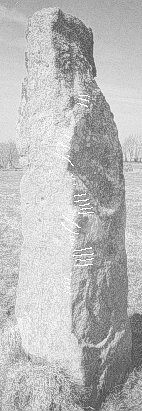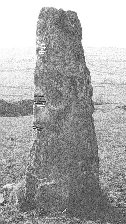According to Macalister, CIIC, this "stone had fallen, and was re-erected, presumably as a cattle rubbing-post, in or about 1861; but the inscription was first noticed by Sergeant Lyons, in 1900" [for Sgt. Lyons cf. {4: Kilmannia}]. "It had been badly injured some time before by boys, who lit a fire against the stone".
It should have been noted that the stone stands in a field (today belonging to one "Ballybeg House") nearly on the top of a hill which forms part of the border between Mayo and Roscommon, immediately opposite the ruined church of Kiltullagh. It is therefore well conceivable that it might have served as a landmark.
Size according to Macalister, CIIC: 6'5" x 1'7" x 1'7"
Published illustrations:
- Macalister, CIIC 1, 8 (draft).
QEGNA MAQI NAN M[UCOI ?....]
Rhßs's reading reminds of the inscription at Cool East {232} with QENGA MAQI SAV MUCOI Q....N [a reading given up totally in CIIC]; "Nav, if that be the reading" of the patronym, "might perhaps be regarded as the base of *Navagn-, the Naebhan of the Annals of the Four Masters".
Reading Rhys (where? quoted by Macalister, CIIC):
QAVIGNI MAQI NANIM ..
QASIGN[I] MAQ[I] ...
Macalister opposes against the continuation as read "doubtfully" as NANIM by Rhßs, which he "could not find at all. Of S1 only the distal end remains: Rhßs missed this .. 1Q3,4,5 are slighly sloped in contrast with the other two scores of this letter, but I could not see that the reading is influenced thereby."
QASIGN[I] MAQ[...
The end of the inscription was destroyed. One of the strokes of the first letter is dubious; maybe we have to read C instead. In this case, we would arrive at a form CASIGNI with a clearer etymology.
Reading Gippert (5.4.1996):
 Dexter-up:
Dexter-up:
[CASEG](N)[I MAQ V
[îíâêèåãð](êé)[åäæïâîí....é...
ëëë[ë](â)[çç]çç[ââââï](ï)[ç](ç)ççç[âââ ïâ ë ë ççç
Nearly no letters of the name are beyond doubt; Q- cannot be ascertained as against C-. MAQ- seems quite clear. After this, an additional row of letters might have existed on an edge branching off from the vertical angle to the right; this seems not to have been noted by Macalister, as his drawing shows; cp. an edited version of this. Maybe the three B-strokes that seem to be recognizable form part of what Rhßs read as NANIM. These and what Rhßs regarded as an M have been marked in  fig. 12. The photograph shows, however, that there is hardly space enough for his I.
fig. 12. The photograph shows, however, that there is hardly space enough for his I.
Additional literature:
- [Lyons?], JRSAI 30, 1900, 164;
- Rhys, JRSAI 31, 1901, 176.
Last changes of this record: 14.04.97
Copyright Jost Gippert, Frankfurt a/M 1996. No parts of this document may be republished in any form without prior permission by the copyright holder.  Dexter-up:
Dexter-up: fig. 12. The photograph shows, however, that there is hardly space enough for his I.
fig. 12. The photograph shows, however, that there is hardly space enough for his I.











